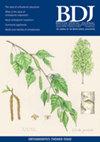A service evaluation assessing the root canal referral and treatment pathway within the Royal London Dental Hospital
IF 2
4区 医学
Q2 DENTISTRY, ORAL SURGERY & MEDICINE
引用次数: 0
Abstract
Aim Within the National Health Service (NHS) England, dental hospitals are tasked with assessing and managing complex root canal treatments (RCTs) referred from various service providers. The aim of this service evaluation was to investigate the root canal treatment and retreatment (RCreT) output, case complexity designation and referral pathways to the Royal London Dental Hospital. Methods Data were collected and analysed on non-surgical RCTs completed between 1 April 2021 to 31 March 2022, including the number of completed treatments, reason and origin of referrals, referral-to-treatment timelines and complexity of treatments. Results In total, 339 teeth met the inclusion criteria, with external referrals (n = 198) taking an average of 47 weeks from referral to treatment commencement compared to 16 weeks for internal referrals (n = 141). Maxillary incisors and first permanent molars were most commonly referred, with anatomical challenges (33.5%), RCreT (32.2%) and trauma (18%) being the most common reasons. Treatment was completed within an average of 2.7 appointments, with a high proportion of complexity Level 2 and 3 cases being completed. Conclusions The RCT output was shown to be increasing within the service. External referrals are taking longer to be seen and treated compared to NHS targets and internally referred patients; although, further information is needed to understand the exact cause of this. Allocation of treatment complexity appeared to be in line with the clinician''s skill set and experience level, taking an average of 2.7 appointments to complete treatment. Further information on the number of referrals, available consultations and clinic space would provide additional insight into the efficiency and pressures of the service.

求助全文
约1分钟内获得全文
求助全文
来源期刊

British Dental Journal
医学-牙科与口腔外科
CiteScore
3.10
自引率
15.40%
发文量
1096
审稿时长
4-8 weeks
期刊介绍:
The role of the BDJ is to inform its readers of ideas, opinions, developments and key issues in dentistry - clinical, practical and scientific - stimulating interest, debate and discussion amongst dentists of all disciplines. All papers published in the BDJ are subject to rigorous peer review.
 求助内容:
求助内容: 应助结果提醒方式:
应助结果提醒方式:


